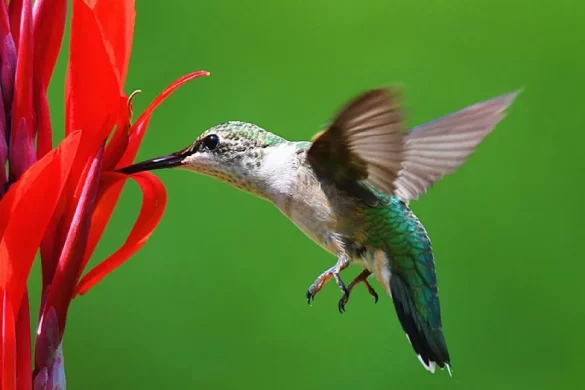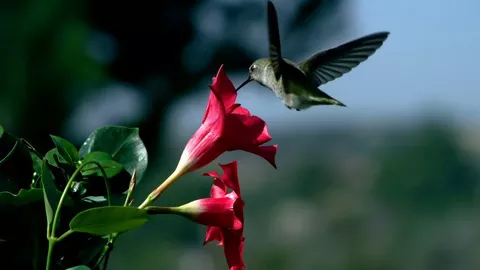Hummingbirds are a captivating and enchanting part of the natural world, known for their iridescent plumage and incredible aerial acrobatics. These tiny creatures possess an insatiable appetite for nectar, which fuels their high-energy lifestyles. While they are drawn to a variety of flowers that provide this vital sustenance, one plant that often captures their attention is the Mandevilla. In this article, we delve into the intricate relationship between hummingbirds and Mandevilla plants.
What is Mandevilla: A Brief Overview
Mandevilla (Mandevilla spp.) is a genus of flowering vines belonging to the Apocynaceae family and is native to Central and South America. Known for its striking trumpet-shaped flowers and lush green foliage, Mandevilla has become a popular choice among gardeners seeking to attract hummingbirds to their landscapes. The plant’s vibrant hues and abundant nectar production make it a prime candidate for these energetic birds’ attention. The pendulous clusters of flowers, available in various shades including pink, red, white, and yellow, are believed to be particularly appealing to hummingbirds due to their bright and easily distinguishable colors.
Why Are Hummingbirds Attracted to Mandevilla?
Several factors contribute to the strong attraction between hummingbirds and Mandevilla plants:
Color and Shape: Hummingbirds are drawn to vibrant, bright colors like red, pink, and orange. The trumpet-shaped blossoms of Mandevilla not only offer a convenient landing platform but also display colors that are irresistible to these birds.
Nectar Content: Mandevilla flowers produce ample amounts of nectar, a rich energy source for hummingbirds. The high sugar content of this nectar provides a quick and easily digestible source of energy, making it an attractive option for these active birds.
Aromatic Fragrance: The sweet aroma emitted by Mandevilla flowers serves as a potent olfactory signal, guiding hummingbirds to their source of nourishment.
Abundance: When Mandevilla vines are planted in clusters or arrays, they create a visually stunning display that further enhances their attractiveness to hummingbirds. The presence of multiple flowers in close proximity increases the likelihood of bird visits.
Planting Mandevilla to Attract Hummingbirds: Tips for Success
If you’re an avid birdwatcher or a gardening enthusiast with a keen interest in attracting hummingbirds, planting Mandevilla could be a rewarding endeavor. To optimize the chances of attracting these delightful birds, consider the following tips:
Color Variation: Opt for a variety of Mandevilla flower colors to cater to different hummingbird preferences and increase the chances of drawing in a diverse group of visitors.
Strategic Placement: Plant Mandevilla near windows, seating areas, or other vantage points to allow for easy observation of hummingbird activity.
Maintenance: Regularly care for and prune your Mandevilla plant to ensure it remains healthy and continues to produce abundant flowers and nectar.
Complementary Plants: Pair Mandevilla with other nectar-rich flowers to create a hummingbird-friendly oasis in your garden.
How To Grow Mandevilla?
Mandevilla like heat, and lots of it. But they can still become scorched in the extreme heat and benefit from a little light or partial shade during the warmest part of the day in the hottest areas.
Though they like a relatively humid environment, these vines will thrive in the warmest climate zones without excessive watering. In containers, you will need to make sure you keep the medium from drying out entirely, but in the ground, they are reasonably tolerant of relatively low water levels.
These plants like sandy and free-draining slightly acidic – neutral soil. A peat-free multipurpose potting mix with added sand can be ideal when filling containers for these plants.
If you do decide to grow Mandevilla as an annual in cooler climes, growing in containers is the best method because you will be able to move it quickly undercover or indoors when colder weather threatens.
Remember, these plants require temperatures above 45 degrees F at all times to stay alive, and temperatures should remain above a minimum of 60 degrees F during the day.
Conclusion
The relationship between hummingbirds and Mandevilla plants exemplifies the delicate interplay between nature’s intricate designs. The vibrancy of the Mandevilla’s flowers, coupled with their tubular shape and nectar production, make them an appealing choice for hummingbirds seeking nourishment. By understanding the preferences and adaptations of both these fascinating birds and the captivating plants they visit, we gain a deeper appreciation for the delicate balance that exists within the natural world. So, if you’re considering adding Mandevilla to your garden, rest assured that you’re not just cultivating a plant; you’re creating an inviting haven for the enchanting world of hummingbirds.
FAQs About Hummingbirds
Q1. Do Hummingbirds Like Petunias?
Yes, hummingbirds are known to be attracted to petunias. Petunias produce bright and colorful flowers, such as red, purple, and pink, along with their trumpet-shaped flowers, make them a favorable choice for hummingbirds.. The nectar within the flowers provides a source of energy for the birds, and their vibrant colors also catch the attention of these small, nectar-feeding birds.
Q2. Do Hummingbirds Like Hibiscus?
Yes, hummingbirds are attracted to hibiscus flowers. Hibiscus flowers produce nectar, which is a primary food source for hummingbirds due to their high energy content. The tubular shape of hibiscus flowers makes them well-suited for hummingbirds, as these birds have long, slender bills that can easily reach into the flowers to access the nectar.
The bright colors of hibiscus flowers, such as red, orange, and pink, also attract hummingbirds. These birds are attracted to vibrant and brightly colored flowers as they have good color vision and can detect these colors from a distance. The color, shape, and nectar content of hibiscus flowers make them a favorite among hummingbirds.
Q3. Do Hummingbirds Like Geraniums?
While geraniums are not known to be as attractive to hummingbirds as some other flowers, such as petunias or hibiscus, it is still possible to see hummingbirds visiting geraniums for nectar. The vibrant colors of geranium flowers can catch the attention of hummingbirds, and if there is a scarcity of other nectar sources available, hummingbirds may visit geraniums for a quick meal. However, it is worth noting that there are many other flowers that are more appealing and provide a better source of nectar for hummingbirds.
Q4. Do Hummingbirds Like Lavender?
While lavender is not a top choice for hummingbirds, they may occasionally visit lavender flowers for nectar. Lavender flowers produce a mild and subtle fragrance that is not as strong or appealing to hummingbirds compared to other more vibrant and aromatic flowers. Hummingbirds are typically attracted to brightly colored, tube-shaped flowers that are rich in nectar. However, if there is a limited availability of other nectar sources, hummingbirds may still visit lavender blooms. It’s always a good idea to plant a variety of flowers to provide a diverse and abundant food source for hummingbirds.
Q5. Do Hummingbirds Like Lantana?
Yes, hummingbirds are attracted to lantana flowers. Lantana is a popular choice for hummingbird gardens as it produces clusters of bright, tubular flowers that are rich in nectar. The vibrant colors of lantana, such as red, orange, and pink, catch the attention of hummingbirds, making them a favorite plant for attracting these tiny birds. Lantana flowers bloom continuously throughout the summer, providing a reliable and long-lasting food source for hummingbirds. Adding lantana to your garden can help attract and sustain hummingbirds.
Q6. Do Hummingbirds Like Begonias?
Hummingbirds are not typically attracted to begonias. Begonias do produce flowers, but their nectar content is relatively low and their shape is not particularly suited to hummingbirds’ feeding habits. Hummingbirds are more attracted to bright and tubular flowers that produce ample amounts of nectar. While begonias may add beauty to your garden, they are not a favored choice for attracting hummingbirds. It’s advisable to incorporate other flowers, such as petunias or salvias, that are known to attract hummingbirds if that is your goal.
Q7. Do Hummingbirds Like Honeysuckle?
Yes, hummingbirds are highly attracted to honeysuckle flowers. Honeysuckle produces tubular-shaped flowers that are rich in nectar, which makes them a popular choice for hummingbirds. The long, narrow shape of the flowers is well-suited for the hummingbirds’ long beaks, allowing them to easily access the nectar inside. Additionally, honeysuckle flowers often have bright and vibrant colors, which further attract hummingbirds. Planting honeysuckle in your garden or putting up a trellis with honeysuckle can help entice hummingbirds to visit and provide them with a reliable food source.
Q8. Do Hummingbirds Like Roses?
While hummingbirds are not typically drawn to roses for their nectar, they may occasionally visit them if other preferred food sources are scarce. Roses do produce some amount of nectar, but it is not as rich or abundant as that found in many other flowers that hummingbirds find more appealing. Hummingbirds are generally attracted to flowers that have tubular shapes, bright colors, and a high nectar content. However, if you have roses in your garden, you may still occasionally spot hummingbirds exploring the blooms for nectar. It is always a good idea to provide a variety of flowers that are known to attract hummingbirds to ensure a reliable food source for these delightful birds.
Q9. Do Hummingbirds Like Warm or Cold Nectar?
Hummingbirds generally prefer warm or room temperature nectar. Cold nectar can hinder their digestion and metabolism. It is recommended to offer nectar solutions that are at room temperature or slightly warm. However, be cautious not to make the nectar too hot, as it can cause burns or scald the hummingbirds’ delicate tongues. So, offering nectar at a temperature similar to the environment will be more appealing and beneficial for these tiny birds.



 Facebook
Facebook  Instagram
Instagram  Youtube
Youtube 